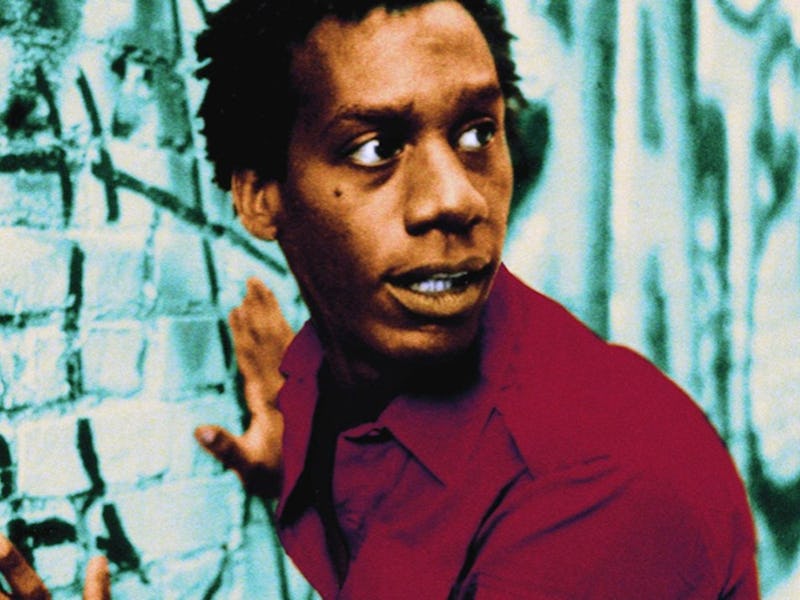The Best Sci-Fi Movie You Haven’t Seen Combined Superheroism with the Silent Film
Months before John Carpenter's Starman hit theaters, an indie flick told its own stranded alien story.

Compared to the bloated multiverse era where “less is more” is an alien concept, 1984 cult favorite The Brother from Another Planet seems like it’s been beamed in from an entirely different celestial body. Its $350,000 budget — a small sum even for the time — would be lucky to cover 30 seconds of a Marvel flick. Its special effects are limited to a few glowing lights and a deformed toe. And far from delivering any grandstanding speeches, its superhero is entirely mute.
The titular Brother, who’s not even given the luxury of a name, is an extra-terrestrial whose powers are far more intuitive (he can hear voices from the past by touching his surroundings) than communicative. But thanks to a nuanced performance from future Emmy winner Joe Morton, he still manages to convey the emotional complexities of the immigrant experience (just to make it clear the film is allegorical, his primitive spaceship crashlands on Ellis Island).
The silent outsider isn’t the only alien navigating his way through the streets of New York. Hot on his heels are the two intergalactic slave catchers (David Strathairn and the movie’s director and screenwriter, John Sayles) determined to thwart his bid for freedom. But Another Planet is more interested in exploring how its protagonist adapts to his new environment than serving up cat-and-mouse chases.
The Brother’s efforts to ingratiate himself to the city’s hustle and bustle are often played for laughs; a comedy of errors in a Korean bodega sees him eat lettuce like an apple and then pay for it using the aggrieved proprietor’s own takings. Later, he meets a street magician (Fisher Stevens) whose perfect timing produces a trick that amusingly doubles as commentary on how the Big Apple still has a problem with segregation.
Joe Morton’s Brother seeking refuge in the nearest bar.
Then there’s the local barroom regulars who initially treat his wordless demeanor with disdain before recognizing he could be an asset to the community; not only can he repair arcade machines with a hovering hand, he can also turn the most sedentary of shoot-em-ups into high-octane thrillfests using the power of his mind.
This cast of oddball characters, the majority of whom are first- or second-generation immigrants themselves, are so intriguing that you're more than happy for their conversations to be one-sided, their natural way with words allowing their new acquaintance to learn about racial prejudice, gentrification, and everything in-between.
The Brother even gets a romantic subplot after falling head over heels for club singer Malverne Davis (Dee Dee Bridgewater). “I don’t know why I like you so much, you could be anybody,” she tells him during their night of passion, alluding to the fact the stranger in her bed is both a magnetic presence and a blank canvas for both characters and viewers to project their own emotions upon.
The Brother showcasing his distinctive brand of bedroom talk.
While native New Yorker Sayles — who self-funded the film via TV sales of his directorial debut Return of the Secaucus 7 and a MacArthur Fellows grant — often presents his hometown as a place where kindness prevails, he isn’t afraid to show its much darker underbelly, either. His vignette approach eventually takes a sinister turn when our hero is mugged by two street punks, later discovers one has succumbed to an overdose, and then transforms into a blaxploitation-style vigilante hellbent on cleaning up the streets.
Ironically, Another Planet isn’t quite as compelling when it picks up some narrative drive, although the Brother’s subsequent journey into the city’s narcotics-fueled underworld does have a few moments of inspiration, like the scene where he uses his removable eyeball as a video recording device. And Spike Lee cohort Ernest R. Dickerson frames the Harlem landscape just as effectively in its twilight hours as he does its sun-soaked afternoons.
But the nightmarish sequences sparked by his own pharmaceutical curiosities, including an intense neighborhood history lesson with a Rastafarian named Virgil, espouse its anti-narcotics message with the subtlety of a sledgehammer. In contrast, the showdown with the man responsible for flooding the city with illicit substances — a privileged white guy The Brother forces to get high on his own supply — is underplayed.
The Brother’s unusual recording device.
Still, the climactic showdown offers a few fireworks as the Men in Black finally track down their prey, only to discover The Brother isn’t the only alien who’s assimilated into a New York state of mind. As with all the action that's gone beforehand, Sayles makes a little go a long way, whether reversing footage to achieve the villains’ eerie, uncanny valley movements or eventually knocking them off via the world’s tidiest spontaneous combustion.
The Brother from Another Planet’s thunder was stolen a few months later by John Carpenter’s Starman, a similarly-themed tale of a human-passing alien being tracked down by nefarious forces. But Sayles’ labor of love remains the pinnacle for those who prefer their sci-fi parables with quieter hangout vibes.